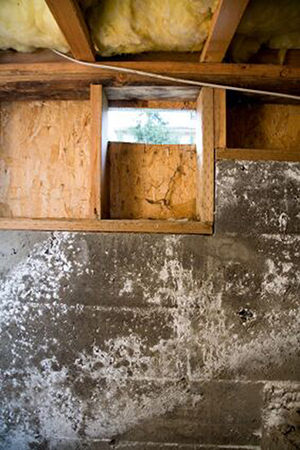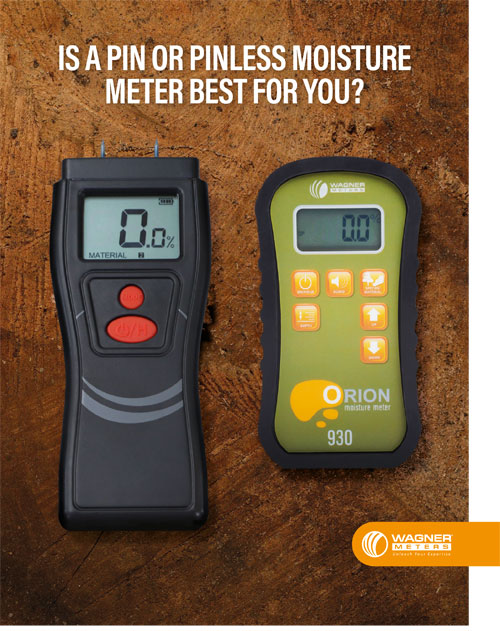How a Moisture Meter Can Help Find Moisture and Mold Growth
Can a Moisture Meter Detect Mold?
No, a moisture meter can’t detect mold, but moisture meters can accurately detect moisture pockets which might cause mold growth. By using a pinless moisture meter you can check the surface of the area to identify areas with too much moisture. Moisture meters help detect moisture spots with possible mold growth. If your MC reading in wood is more than 20%, you may want to check these areas for mold growth. When the MC is above 20%, this is possibly where mold growth can start to happen.
Humans have reason to attach negative connotations to mold. When food goes bad, mold appears. When a living space contains too much-unventilated moisture, mold grows. Leaves rot on the ground and form mold. Fabric stored in damp places gets its musty smell from the presence of mold.
 More seriously, mold releases chemicals and spores into the air when growing inside a home. Over time, such growth can adversely affect human health. Contrary to public perception, mold has a fairly simple resolution: moisture content (MC) measurement and control.
More seriously, mold releases chemicals and spores into the air when growing inside a home. Over time, such growth can adversely affect human health. Contrary to public perception, mold has a fairly simple resolution: moisture content (MC) measurement and control.
The Icky-ness of Mold
Here are some more basic points on understanding mold:
- Mold’s impact on us is based on where it grows.
- Mold needs moisture to grow.
- Dampness inside building materials can cause mold to grow.
- Mold will not grow on dry materials.
- Mold can begin in environments where no water can be seen.
How It Happens
 Moisture is present in any building because it is part of our natural environment. Builders construct homes using wood and concrete (among other materials). Both contain moisture within, and a healthy degree of moisture remains inside the building materials. Professional installers use a moisture meter to measure the MC of their materials during the building process to ensure that safe moisture levels are achieved. However, moisture meter technology has evolved so that contractors and also consumers can also monitor these building materials on a regular basis to determine if their MC changes.
Moisture is present in any building because it is part of our natural environment. Builders construct homes using wood and concrete (among other materials). Both contain moisture within, and a healthy degree of moisture remains inside the building materials. Professional installers use a moisture meter to measure the MC of their materials during the building process to ensure that safe moisture levels are achieved. However, moisture meter technology has evolved so that contractors and also consumers can also monitor these building materials on a regular basis to determine if their MC changes.
What Causes Moisture in Walls?
Although builders seldom deal with mold during construction, homeowners certainly live in perpetual moisture environments in the home and in their workplaces. Moisture imbalance has many potential origins. Moisture can migrate through wood and concrete floors, it can leak from plumbing, it is produced by the daily routines of bathing, washing, and cooking. Moisture naturally accumulates in homes, and its excess needs to be ventilated.
Even changes in relative humidity (RH) can influence the building materials MC. When RH is high, materials such as wood absorb water vapor from the air; when RH is low, the same material releases water vapor to try to reach its equilibrium state. Building materials are interactive with the RH and the temperature of their surrounding environments. This is not to be feared as a problem, but to be embraced as a simple moisture management truth.
Where it becomes a problem is when there is too much unventilated moisture in a specific area leads to mold growth.

Free Download – Is a Pin or Pinless Moisture Meter Best For You?
What Are the Warning Signs of Mold?
- Discoloration: Place a drop of household bleach on a suspected mold spot; if the stain loses its color or disappears, it may be mold.
- Musty/earthy smell: This may indicate the presence of some types of mold.
- Water stains or dampness: These indications of a moisture problem will often lead to mold if left untreated.
How to Eliminate Mold
You cannot eliminate moisture totally, but you can eliminate moisture problems that can lead to mold. The tonic for being out of balance is being balanced. Building trade professionals use a moisture meter that measures the amount of MC in wood building materials and a moisture test that measures the RH of the concrete slab. The measured MC for wood and the RH for concrete slabs are displayed in percentage, and quality builders know the moisture targets of their materials for optimum building construction. In essence, they have the tool to stop mold before it even begins to grow.

Professionals monitor moisture conditions through the production and installation of their wood building materials and during the curing of concrete slabs in order to make the best construction decisions for a successful project.
Is There a Moisture Meter to Test for Mold?
Wagner Meters produces moisture meters and moisture tests for a variety of products – wood, concrete, or multi-material building applications. Using proprietary technology, Wagner Meters’ hand-held wood and building inspection moisture meters quickly scan materials to obtain instant MC measurement results. Consumers can now purchase their own meter to look for potential moisture problems in their homes that will fit in their utility drawer, and quickly and proactively fix moisture problems before they lead to mold issues.
Moisture will always be with us, but its excess need not produce mold in the modern home. Use a good moisture meter, and maintain the appropriate levels of moisture which deprive mold of its opportunity.
As Sales Manager for Wagner Meters, Ron has more than 35 years of experience with instrumentation and measurement systems in different industries. In previous positions, he has served as Regional Sales Manager, Product and Projects Manager, and Sales Manager for manufacturers involved in measurement instrumentation.
Related Posts via Taxonomies
Last updated on May 25th, 2021




This is a very helpful article. We have found that mold damage is usually the result of hidden moisture. As a mold water damage specialist in South Florida, we often find roof damage is the most common. Once a homes roof is compromising the rain water, soaks into the insulation where is may sit for weeks or even months. It only takes 24-48 hours for mold to start growing. Once that happens your homes walls or ceiling will need to be replaced. My advise is the homeowner need to form the habit of searching for water spots on walls and ceilings on a regular basis.
Can a mold meter detect mold under ceramic tiles in the bathroom?
Zeenat,
You will need to check with the manufacture of the meter to determine its use. Thanks for writing in.
Is there a % on my moisture meter that is when mold will grow inside a wall
Hi Lynn,
Thank you for writing in. Moisture meters do not have a percentage that will show mold. That said, I would go to NWFA.org. They have wonderful information on their site.